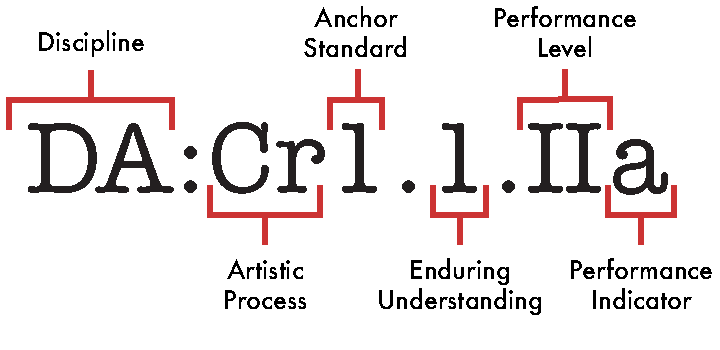The Delaware arts standards use a coding system that identifies each element of a standard, from artistic process to performance indicator. The code also includes a grade level (for PK to 8) or a performance level (for high school). The information below outlines this coding system.
Art Discipline
Each discipline is assigned an alphabetic abbreviation using uppercase letters
MA = Media Arts
MU = Music
TH = Theatre
VA = Visual Arts
Artistic Process
Each artistic process is assigned an alphabetic abbreviation using an upper and lowercase letter
Pr = Performing/Presenting/Producing
Re = Responding
Cn = Connecting
Anchor Standard
Each anchor standard is assigned a number.
Creating
- Generate and conceptualize artistic ideas and work.
- Organize and develop artistic ideas and work.
- Refine and complete artistic ideas and work.
Performing/Presenting/Producing
- Analyze, interpret and select artistic work for presentation.
- Develop and refine artistic techniques and work for presentation.
- Convey meaning through the presentation of artistic work.
Responding
- Perceive and analyze artistic work.
- Interpret intent and meaning in artistic work.
- Apply criteria to evaluate artistic work.
Connecting
- Synthesize and relate knowledge and personal experiences to make art.
- Relate artistic ideas and works with societal, cultural and historical context to deepen understanding.
Enduring Understandings
The Anchor Standards (AS) are the same across all arts disciplines. However, each discipline’s standards have discipline-specific interpretations of the AS, called Enduring Understandings (EU). EUs guide the content of the Performance Indicators. Some Anchor Standards in some of the arts disciplines have more than one EU. To create code alignment between all standards and disciplines, AS numbers are always followed by “.1”, “.2”, like this: 1.1, 1.2. “.1” follows the AS number even when there is only one Enduring Understanding.
For Pre-K to 8th grade, grade level is indicated by letters or a grade number.
- PK = Pre-Kindergarten
- K = Kindergarten
- 1, 2, 3, 4, 5, 6, 7, 8 = grades 1-8
High School performance levels are indicated by Roman numerals.
- I = HS Proficient
- II = HS Accomplished
- III = HS Advanced
Additional Codes for Music Standards
Unlike the other arts disciplines, there are five sets of performance indicators for music. A one-letter code is added after the enduring understanding code for all but one set of the performance standards to indicate the music “strand”:
E = Ensembles
C = Composition and Theory
T = Technology
Performance Indicator
Each Performance Indicator (PI) is assigned a lowercase letter even when there is only one. The first performance indicator is “a”, the next “b”, and so on.
Ordering
- First position indicates the discipline. It is always followed by a colon ( : ).
- Second position (following the colon) indicates the Artistic Process.
- Third position indicates the Anchor Standard number and Enduring Understanding number, separated by a “.”
- Optional Music Strand, separated by a “.”
- Fourth position indicates the Grade Level.
- Fifth position indicates the Performance Indicator.
Examples
This example is for Theatre, Performing/Presenting/Producing:

This example is for Dance, Creating:

This example is for Music, Ensemble strand, Responding:


